Best Way to Use Snow Blower Essential Steps for Efficient and Easy Snow Removal
- January 29, 2024
- 0 comment
Snow removal can be a daunting task, especially in areas where heavy snowfall is a common occurrence. However, with the right tools and techniques, this chore can become manageable, even easy. Among the most effective tools for snow removal is the snow blower. This article explores the essential steps for using a snow blower efficiently, covering everything from preparation to maintenance.
Understanding Snow Blowers
Snow blowers, with their array of types and features, are essential for tackling winter’s wrath efficiently, yet choosing the right one hinges on a deep understanding of their capabilities. From lightweight electric models suited for quick cleanups of light snowfalls to robust gas-powered units designed for clearing deep snow over expansive areas, each variant offers unique benefits tailored to different snow removal needs. Features like clearing width, intake height, and advanced options such as power steering and heated handgrips further refine the selection process, ensuring that users find a snow blower that not only addresses their specific challenges but also enhances the snow removal experience, making it crucial for individuals to assess their environment and snowfall patterns closely before making a purchase.

Types of Snow Blowers
Snow blowers are available in a range of models such as single-stage, two-stage, and three-stage, each tailored to varying snow conditions and property sizes.
| Snow Blower Type | Weight and Maneuverability | Suitability | Features |
|---|---|---|---|
| Single-Stage | Lightweight and easy to maneuver | Light snowfall; Smaller properties | Ideal for clearing snow up to 8 inches deep. Directly collects and throws snow in one motion. |
| Two-Stage | More powerful, less maneuverable than single-stage | Heavier snowfall; Larger areas | Uses an auger for gathering snow and an impeller to expel it through the chute. |
| Three-Stage | Heavy-duty and less maneuverable | Heavy snowfall; Larger properties | Includes an auger and impeller, plus an accelerator to speed up snow removal. |
Key Features to Look For
Selecting the right snow blower involves a thoughtful consideration of several key factors to match the equipment to your specific snow removal needs effectively. The power source is a critical aspect, as snow blowers can be electric, battery-powered, or gas-operated, each offering distinct advantages and limitations. Electric models are typically lighter and require less maintenance, making them ideal for small areas and lighter snowfalls. In contrast, gas-powered snow blowers provide more robust performance and mobility for tackling larger areas and heavier snow, but they demand more maintenance.
Battery-Powered Snow Blower
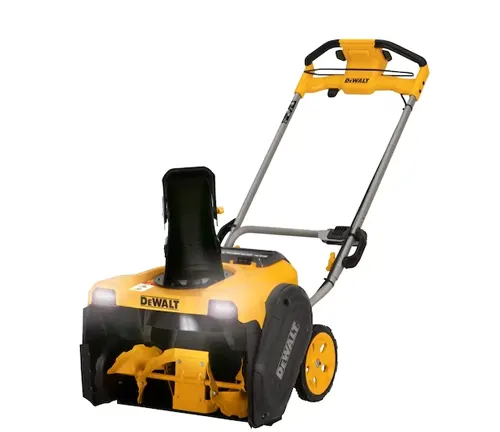
Gas-Powered Snow Blower
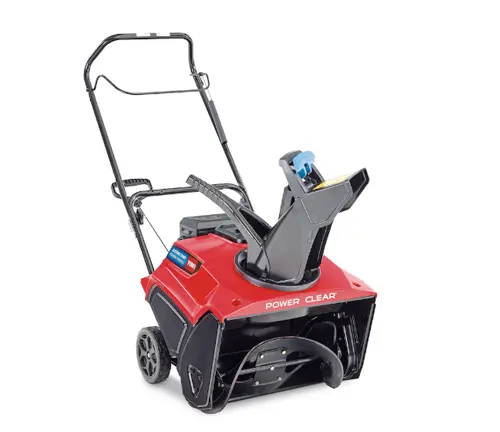
Another important consideration is the clearing width, which determines how much snow can be cleared in a single pass. Wider clearing widths can significantly reduce the time spent on snow removal in large driveways or expansive spaces. The intake height, or the height of the opening that collects the snow, is also crucial, especially in regions prone to deep snowfalls. A higher intake height ensures the snow blower can handle deep accumulations without getting bogged down. Together, these factors play a pivotal role in finding a snow blower that not only meets your expectations for performance but also aligns with the physical demands of your snow removal tasks.
Preparing for Snow Removal
Thorough preparation is essential for ensuring both the effectiveness and safety of snow removal efforts. Here’s are some preparations you can do:
- Inspect and Maintain Equipment
Ensure snow removal tools, especially snow blowers, are in optimal condition by checking all moving parts, fluid levels, and making necessary repairs before winter. - Review Safety Guidelines
Familiarize yourself with the operation manuals and safety instructions of your equipment to prevent accidents and injuries. - Plan Snow Removal Strategy
Determine the sequence in which areas will be cleared and assess potential obstacles to streamline the process and avoid property damage. - Prioritize Safety and Efficiency
Proper preparation enhances the snow removal experience, focusing on personal safety and the careful handling of property.
Safety Precautions
Begin by acquainting yourself with essential safety measures, which include donning the right attire and fully grasping how your snow blower functions. Here’s what you can do.
- Wear Appropriate Clothing
Dressing appropriately for snow removal is essential for both warmth and safety. Wear layers to adjust to varying temperatures, slip-resistant boots to prevent falls, gloves to protect your hands from the cold and machinery, and eye protection to shield against flying debris. - Clear the Area
Prior to engaging your snow blower, walk through the area you intend to clear and remove any objects like rocks, toys, or branches. These items can become dangerous projectiles if picked up by the snow blower, potentially causing injury or damage to property. - Keep Hands and Feet Clear
One of the most common snow blower injuries occurs when operators attempt to clear clogs with their hands or feet. Always use a clearing tool or stick to remove clogs or debris from the chute or augers, and ensure the machine is completely powered off before doing so. - Turn Off When Adjusting
If you need to make any adjustments to your snow blower or if it requires troubleshooting, always turn off the engine first. This prevents the accidental engagement of the machine while your hands are near moving parts. - Use in Well-Lit Areas
For your safety, only use your snow blower in daylight or in well-lit conditions. Good visibility is crucial to avoid obstacles and ensure that you’re clearing snow safely and effectively. - Avoid Carbon Monoxide Exposure
Gas-powered snow blowers emit carbon monoxide, a dangerous, odorless gas. Never start or run your snow blower in a garage, shed, or any other enclosed space to prevent carbon monoxide poisoning. - Stay Focused
When operating a snow blower, it’s important to stay focused on the task at hand. Distractions can lead to accidents, so be mindful of your surroundings and the operation of the machine at all times.
Preparing Your Snow Blower
Preparing your snow blower for operation is crucial for both efficiency and safety. Follow this step-by-step guide to ensure your machine is ready to tackle the snow:
- Consult the Manual
Start by thoroughly reading your snow blower’s manual. Understanding your specific model’s features, controls, and maintenance recommendations is key to proper preparation. - Check the Fuel
For gas-powered snow blowers, ensure you have fresh fuel and that the fuel level is adequate. If your model has been sitting idle for a long time, consider draining old fuel and replacing it with fresh gasoline. - Inspect the Oil
Check the oil level and quality. If the oil is dirty or low, replace or top it up as needed to ensure your engine runs smoothly and to prevent damage. - Examine the Tires
Ensure the tires are properly inflated to the recommended pressure. This is crucial for maintaining traction and stability while operating the snow blower. - Inspect the Auger and Impeller
Check the auger and impeller for any signs of wear or damage. Make sure they move freely without obstruction, and replace or repair any worn or damaged parts. - Test the Controls
Verify that all controls, including the start switch, throttle, auger, and drive levers, are working correctly. Adjustments or repairs should be made as needed to ensure full control during operation. - Clear the Chute
Make sure the discharge chute is clear of any debris or remnants from previous use. A blocked chute can hinder snow removal and pose a safety risk. - Lubricate Moving Parts
Apply lubricant to any moving parts as recommended by the manufacturer. This can include the chute rotation mechanism, cables, and any other pivot points to ensure smooth operation. - Charge the Battery
For electric or battery-powered models, ensure the battery is fully charged before starting. A full charge guarantees that your snow blower will be ready for use when you need it.
By following these preparation steps, your snow blower will be in optimal condition for efficient and safe snow removal.
Best Way to Use Snow Blower
To maximize the efficiency of your snow blower, adopting a systematic approach tailored to the specific conditions of the snow you’re dealing with is essential. This means not only following a sequential process to ensure your machine is properly prepared and used but also making adjustments to its settings based on the type of snow you’re facing. For instance, lighter, fluffier snow may require less aggressive settings and a faster pace, whereas wet, heavy snow might necessitate slower speeds and higher power settings to effectively move the snow without overburdening the machine.
Here’s a table outlining how to adjust your snow blower settings for different types of snow:
| Snow Type | Blower Setting | Speed | Additional Tips |
|---|---|---|---|
| Light and Fluffy | Lower auger and impeller speed | Faster | Light snow can be cleared quickly; avoid overloading the chute. |
| Wet and Heavy | Higher auger and impeller speed | Slower | Take smaller passes to prevent clogging and strain on the blower. |
| Icy or Compacted | Use ice-breaking features if available | Moderate to slow | Be cautious of hidden obstacles and use safety gear. |
| Deep Snow | Highest power setting | Steady and slow | May require multiple passes; start from the top layer. |
Understanding the nuances of your snow blower’s capabilities and how to adapt them to the snow’s consistency and volume can significantly enhance your snow removal efficiency, reducing both the time and effort required to clear your space.
Step-by-Step Guide
For top-notch results with your snow blower, it’s all about strategy – knowing when to start and how to go about it makes all the difference. Let’s break it down into manageable steps:
- Keep an eye on the snowfall. If you can, start clearing the snow early on, especially if it’s still coming down hard. Tackling it in stages can stop it from getting too packed and tough to handle.
- Before the first flake falls, give your snow blower a thorough once-over. Make sure it’s fueled up, oiled, and that all parts are moving smoothly. Sharp blades and a damage-free machine are your best allies.
- Match your snow blower’s settings to the snow you’re dealing with. Light, fluffy snow versus wet, heavy slush will need different approaches, from how you angle the chute to how deep you set the blades.
- Think about the most efficient way to clear your space. For driveways, a middle-out approach works well. Sidewalks might just need a simple back-and-forth.
- Find a rhythm that lets your blower do its thing without bogging down. The right speed lets you clear effectively without overloading the machine.
- Deep snow might need a few passes to manage, and for the really wet, heavy stuff, smaller sections are key to avoid jamming up your blower.
- Wet snow loves to clog up chutes. If you hit a blockage, shut down and clear it safely with a tool – never with your hands.
- After the heavy lifting, go back for any missed spots, setting your blower to skim close to the ground for a clean finish.
- Once you’re done, let your snow blower cool off. Then give it a good wipe-down to keep it rust-free and clear out any leftover snow to keep it in prime condition for the next round.
With this approach, you’re not just moving snow; you’re mastering it, making the whole process smoother and keeping your snow blower in tip-top shape for seasons to come.
Maintenance and Care
Keeping your snow blower in peak condition is crucial for ensuring its longevity and optimal performance through the snowy months. Regular maintenance goes beyond simple checks and can significantly extend the life of your machine while ensuring it operates efficiently and safely.
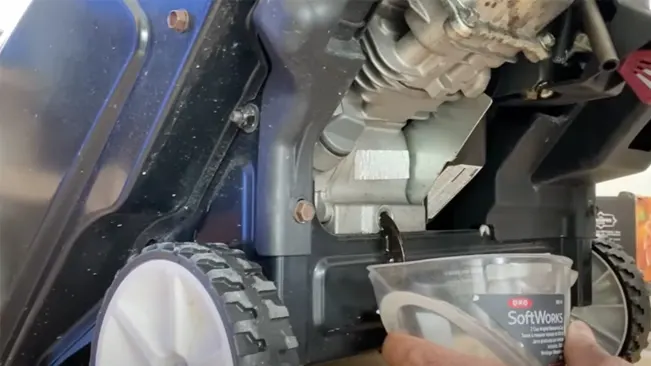
Here’s a detailed guide to regular maintenance and care for your snow blower:
- After each use, take a moment to inspect your snow blower for any signs of wear or damage. Clear out any snow, ice, or debris from the auger, impeller, and discharge chute to prevent rust and corrosion. Wipe down the machine to remove moisture and prevent metal parts from deteriorating.
- Engine oil is the lifeblood of your snow blower. Check the oil level before each use and top it up if it’s low. Regularly changing the oil according to the manufacturer’s recommendations—usually at the start or end of the season—can prevent engine damage and keep your snow blower running smoothly.
- The belts on your snow blower can wear out over time, leading to reduced efficiency or even a breakdown. Inspect the belts periodically for cracks, fraying, or signs of wear and replace them as needed to maintain optimal performance.
- The spark plug is essential for starting your snow blower. Check it at least once a season for deposits or corrosion and replace it if it’s worn or damaged. A fresh spark plug ensures reliable starts and smooth operation.
- For snow blowers with pneumatic tires, maintaining the correct tire pressure is vital for stability and maneuverability. Check the pressure regularly and inflate the tires as needed to the specifications listed in your manual.
- Lubrication helps reduce friction and wear on moving parts, keeping your snow blower running efficiently. Apply lubricant to the auger shaft, gears, and any other moving parts as directed by your snow blower’s manual.
- The vibration from operating your snow blower can loosen bolts and fasteners over time. Periodically check and tighten these components to ensure your snow blower remains stable and safe to use.
- The skid shoes and scraper blade control the height of the auger above the ground. Adjust them as needed to prevent damage to your driveway or sidewalk and to ensure efficient snow removal.
- When the snow season is over, prepare your snow blower for storage by cleaning it thoroughly, changing the oil, and adding fuel stabilizer to the gas tank. Store it in a dry, covered area to protect it from the elements and prevent rust.
By adhering to this regular maintenance schedule, you can ensure your snow blower remains reliable season after season, making each snow removal task as efficient and effortless as possible.
Enhancing Efficiency
Enhancing the efficiency of snow removal with your snow blower doesn’t just happen by chance; it requires employing the right techniques tailored to your specific situation. By optimizing your approach, you can significantly cut down on the time and effort needed to clear snow. Here’s a guide to help you do just that:
- Timing can greatly influence the ease and speed of snow removal. If possible, clear snow early in the morning before it’s compacted by foot traffic or vehicles. Also, consider clearing snow in stages during continuous heavy snowfall to prevent it from accumulating too much.
- Before you start, take a moment to strategize the best path for snow removal. For driveways, begin in the middle and push snow towards the edges. For sidewalks, clear a straight path from one end to the other. Avoiding unnecessary overlaps saves time.
- Tailor your snow blower’s settings to the current conditions. Use a higher auger setting for deeper snow and adjust the chute direction to efficiently disperse the snow away from the cleared area.
- Find a rhythm that allows your snow blower to work effectively without overloading it. Pushing too fast can cause clogs, especially with wet snow, while moving too slowly can prolong the task unnecessarily.
- When dealing with heavy snowfall, make overlapping passes to ensure no snow is left behind. This method also helps prevent the formation of snow walls that can harden and become difficult to remove later.
- Pay attention to the wind direction and use it to your advantage. Aim to throw snow downwind whenever possible to prevent it from blowing back over cleared areas.
- Wet snow can easily clog the chute, slowing you down. Periodically check the chute and use a clearing tool (never your hands) to remove any blockages.
- For exceptionally deep snow, it may be more efficient to remove it in layers rather than attempting to clear the full depth in one pass. Start from the top and work your way down to avoid overburdening your snow blower.
- Keeping your snow blower in top condition is essential for efficient snow removal. Regularly check the oil, fuel, and blades, and ensure all parts are well-lubricated and functioning properly.
- Efficient snow removal is not just about the machine; it’s also about the operator. Make sure you’re well-rested, dressed warmly, and hydrated to maintain your energy and efficiency throughout the task.
Environmental Considerations
Adopting eco-friendly practices in snow removal is not only beneficial for the environment but can also enhance the efficiency and sustainability of the process. One effective approach is to use electric or battery-powered snow blowers, which emit fewer pollutants compared to their gas-powered counterparts. Additionally, applying environmentally safe de-icing agents, such as calcium magnesium acetate instead of traditional rock salt, can reduce harm to plant life and groundwater. It’s also advisable to manually remove snow with shovels in smaller areas to minimize energy consumption altogether.
Moreover, being mindful of where the snow is piled can prevent melting snow from refreezing on pavements or harming nearby vegetation. By integrating these eco-conscious methods, individuals can significantly lessen the ecological footprint of snow removal while maintaining clear and safe outdoor spaces during the winter months.
Eco-Friendly Practices
Selecting the appropriate fuel and ensuring the correct disposal of snow are key steps in enhancing the environmental sustainability of snow blowing practices.
| Aspect | Eco-Friendly Choice |
|---|---|
| Fuel Selection | Opt for electric or battery-operated snow blowers to reduce emissions and decrease reliance on fossil fuels. |
| Snow Disposal | Strategically pile snow in areas where it won’t obstruct drainage systems or harm vegetation, ensuring a natural melt-off. |
Navigating Sloped Areas
Removing snow from sloped areas presents unique challenges that demand specialized techniques to ensure both safety and effectiveness. When dealing with inclines, the risk of slipping or losing control of the snow blower increases, making it crucial to approach the task with caution. It’s advisable to start from the bottom of the slope and work your way up, allowing gravity to assist in the snow removal process. This method also prevents the accumulation of cleared snow at the bottom, which could obstruct your path or create a hazard.
Additionally, choosing a snow blower with adequate traction and power is essential for sloped terrains, as these features help maintain stability and control. For steep slopes, it may be safer to use alternative methods, such as shoveling in combination with eco-friendly de-icing products, to avoid the risks associated with operating heavy machinery on an incline. By employing these targeted strategies, one can navigate the complexities of snow removal on slopes, ensuring a clear and safe environment.
Storage Solutions
Proper storage is crucial for maintaining your snow blower’s longevity. This involves cleaning it thoroughly to remove debris, stabilizing or draining the fuel to protect the engine, and keeping it in a dry, sheltered space to prevent rust and wear. Simple steps like these can extend the life of your snow blower, ensuring it’s ready for action each winter season.
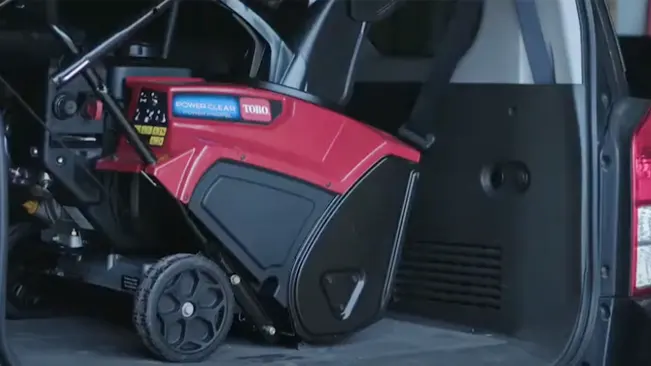
Proper Storage Methods
- Before storing, remove all snow, ice, and debris from the machine. Pay special attention to the auger and chute to prevent rust and corrosion.
- For gas-powered models, either run the engine until the fuel tank is empty or use a fuel stabilizer to prevent the fuel from deteriorating and damaging the engine.
- Replace old oil with fresh oil to keep internal components lubricated and prevent corrosion.
- For safety and to prevent accidental starts, disconnect the spark plug wire.
- Apply lubricant to moving parts such as cables and controls to keep them from sticking or rusting.
- Ensure the tires are properly inflated to avoid flat spots from long-term storage.
- Use a breathable cover to protect your snow blower from dust and moisture, and store it in a dry, sheltered area like a garage or shed.
Common Mistakes to Avoid
Avoid these common mistakes when using and maintaining your snow blower:
- Leaving Fuel in the Tank
Allowing old fuel to sit in the tank can lead to engine damage. - Ignoring Maintenance Schedule
Skipping routine maintenance checks can cause premature wear and tear. - Neglecting Clean-Up
Failing to clean the snow blower after use can result in rust and blockages. - Forgetting to Lubricate
Not lubricating moving parts can cause them to seize or wear out faster. - Overlooking Wear and Tear
Ignoring signs of wear, such as damaged augers or belts, can lead to breakdowns. - Improper Storage
Storing the snow blower outdoors without protection exposes it to damaging elements. - Using Wrong Fuel Type
Filling the snow blower with incorrect fuel can severely damage the engine. - Skipping Safety Gear
Operating without safety glasses or gloves increases the risk of injury. - Not Adjusting Settings for Snow Type
Failing to adjust the snow blower settings for different snow conditions can reduce efficiency. - Operating on Steep Slopes Without Caution
Using a snow blower on steep slopes without proper safety measures can be dangerous.
Conclusion
In conclusion, mastering the use of a snow blower for efficient and easy snow removal hinges on understanding the machine’s capabilities, proper preparation, and employing the right techniques tailored to varying snow conditions. Whether you opt for a single-stage, two-stage, or battery-powered model, each has its unique advantages and considerations. By following a systematic approach to snow removal, maintaining your equipment regularly, and adapting to the specific challenges of your environment, you can significantly enhance the effectiveness of your snow removal efforts. Remember to prioritize safety, both in operation and maintenance, to ensure not only the longevity of your snow blower but also your well-being. With these essential steps, you can transform the daunting task of snow removal into a manageable, and perhaps even enjoyable, winter chore.
FAQs
- Key factors for choosing a snow blower?
Assess snowfall depth, area size, power source (electric, battery, gas), storage space, and desired features. - Preseason preparation for a snow blower?
Inspect for damage, change oil, check spark plug, lubricate parts, and inflate tires. - Techniques to improve snow removal efficiency?
Start early, use strategic patterns, adjust settings for snow type, and work in layers for deep snow. - Proper off-season storage for a snow blower?
Clean thoroughly, change oil, add fuel stabilizer or drain tank, disconnect spark plug, and store dry. - Effectiveness and considerations of battery-powered snow blowers?
Good for light to moderate snow; eco-friendly and quiet but may struggle with heavy snow and have limited runtime. - How often should I perform maintenance on my snow blower?
Conduct routine checks before each use and perform thorough maintenance at the start and end of the snow season. - Can I use a snow blower on all types of surfaces?
Yes, but be cautious on gravel and uneven surfaces. Adjust the skid shoes to prevent picking up rocks or damaging the surface. - What safety gear should I wear when operating a snow blower?
Wear eye protection, gloves, and sturdy, slip-resistant footwear to protect against flying debris and cold conditions. - How do I prevent my snow blower from clogging with wet snow?
Use a slower pace, make narrower passes, and occasionally stop to clear any build-up from the chute and augers. - What should I do if my snow blower starts but then stops running?
Check the fuel level, ensure the spark plug is connected, inspect for clogs in the chute or auger, and verify that all safety switches are engaged.

Charles Hayes
Forestry AuthorI'm Charles Hayes, I bring over 15 years of specialized expertise in landscaping and woodworking, blending artistic design with sustainable environmental stewardship. My career, fueled by a profound passion for the natural world, encompasses extensive education and hands-on experience in creating harmonious, eco-friendly outdoor spaces and responsibly managing forest resources. Recognized for my professional standing, I am committed to continuous learning and certification in cutting-edge practices. My expertise is not only reflected in my work but also in my contributions to community projects, educational workshops, and collaborations with industry leaders. As an authoritative voice in my field, I strive to share knowledge and promote environmentally conscious approaches, making me a trusted resource in landscaping and forestry.





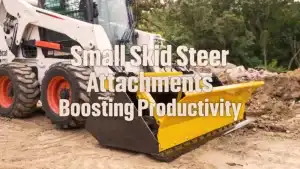







Leave your comment